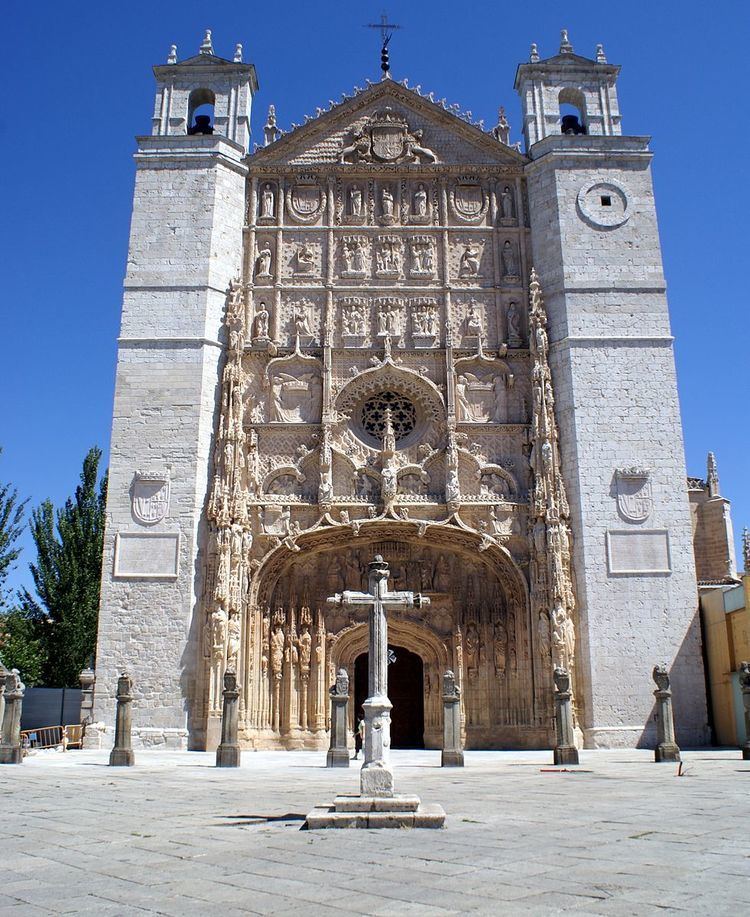 | ||
The Isabelline style, also called the Isabelline Gothic (in Spanish, Gótico Isabelino), or Castilian late Gothic, was the dominant architectural style of the Crown of Castile during the reign of Catholic Monarchs (late-15th century to early-16th century). Emile Bertaux named the style after Queen Isabella of Castile, one of the Catholic Monarchs.
Contents
It represents the transition between late Gothic and early Renaissance architecture, with original features and decorative influences of the Castilian tradition, the Mudéjar, the Flemish, and to a much lesser extent, Italian architecture. The consideration or not of the Isabelline as a Gothic or Renaissance style, or as an Eclectic style, or as a phase within a greater Plateresque generic, is a question debated by historians of art and unresolved.
Overview
The Isabelline style introduced several structural elements of the Castilian tradition and the typical Flanders's flamboyant forms, as well as some ornaments of Islamic influence. Many of the buildings that were built in this style were commissioned by the Catholic Monarchs or were in some way sponsored by them. A similar style called Manueline developed concurrently in Portugal. The most obvious characteristic of the Isabelline is the predominance of heraldic and epigraphic motifs, especially the symbols of the yoke and arrows and the pomegranate, which refer to the Catholic Monarchs. Also characteristic of this period is ornamentation using beaded motifs of orbs worked in plaster or carved in stone.
After the Catholic Monarchs had completed the Reconquista in 1492 and started the colonization of the Americas, imperial Spain began to develop a consciousness of its growing power and wealth, and in its exuberance launched a period of construction of grand monuments to symbolize them. Many of these monuments were built at the command of the Queen; thus Isabelline Gothic manifested the desire of the Spanish ruling classes to display their own power and wealth. This exuberance found a parallel expression in the extreme profusion of decoration which has been called Plateresque.
References to classical antiquity in the architecture of Spain were more literary, whereas in Italy, the prevalence of Roman-era buildings had given 'Gothic' a meaning adapted to Italian classicist taste. Until the Renaissance took hold in the Iberian peninsula, the transition from the 'Modern' to the 'Roman' in Spanish architecture had hardly begun. These terms were applied with a meaning different from what one would expect now— the 'Modern', an originally Spanish style, referred to the Gothic and its rational efficiency, while the 'Roman' was the neoclassical or emotional and sensualist style of the Italian Renaissance.
Regardless of the spatial characteristics of the interiors, Gothic buildings utilized proven structural systems. The Gothic style in the Iberian Peninsula had undergone a series of changes under the influence of local tradition, including much smaller windows which allowed the construction of roofs with substantially less pitch and even flat roofs. This made for a truly original style, yet more efficient construction. Spanish architects, accustomed to their Gothic structural conventions, looked with some contempt on the visible metal braces that Italian architects were forced to put on their buildings' arches to resist horizontal thrust, while their own Gothic building methods had avoided this problem.
The development of classical architecture in the Iberian Peninsula, as elsewhere, had been moribund during the centuries of building construction done in the Gothic tradition, and the neoclassical movement of the Italian Renaissance was late to arrive there. A unique style with modern elements evolved from the Gothic inheritance in Spain. Perhaps the best example of this syncretistic style is the Monastery of San Juan de los Reyes in Toledo; designed by the architect Juan Guas, its Gothic ideals are expressed more in the construction than in the design of the interior space, as the relationship with original French Gothic building techniques had receded with the passage of time.
In the Isabelline style, decorative elements of Italianate origin were combined with Iberian traditional elements to form ornamental complexes that overlaid the structures, while retaining many Gothic elements, such as pinnacles and pointed arches. Isabelline architects clung to the Gothic solution of the problem of how to distribute the weight burden of vaults pressing on pillars (not on the walls, as in the Romanesque or Italian Renaissance styles): that is, by propping them up with flying buttresses. After 1530, although the Isabelline style continued to be used and its decorative ornaments were still evolving, Spanish architecture began to incorporate Renaissance ideas of form and structure.
